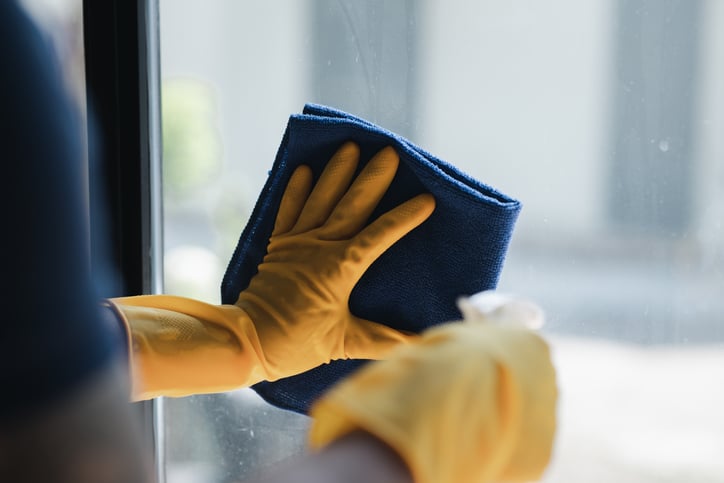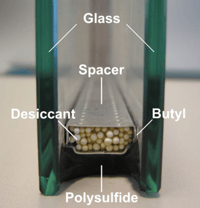
Messes happen. Especially when you’re a person who works with your hands in the manufacturing and construction industries.
Glass is one of the least forgiving substrates when it comes to disguising blemishes or the unsightly spot. Thankfully, it’s also one of the easiest to clean – if you have the right knowledge and tools for the job.
Whether it’s how to remove silicone from glass or how to clean polysulfide from insulated glass unit windows, where there’s a will there’s a way to make your glass squeaky clean before passing it off to your customer.
How to Clean Glass Like a Professional
Different types of glass, including polycarbonate and acrylic, require different substances and tools for cleaning.
Let’s uncover some of the cleaning methods the pros use to:
- Remove silicone from glass
- Clean shower glass
- Remove polysulfide from IGUs
- Get scratches out of Plexiglas
- Clean windows without Windex
Remove Silicone from Glass
You’ve just installed a glass piece and you see smears of silicone caulk have made their way onto the pane. What’s your best plan of action?
Depending on the type of glass, you may or may not want to first lightly scrape off the excess caulk with a 1-inch blade. You should only scrape the piece if you know it can withstand the pressure. Then:
- Using a damp microfiber cloth, rub away the silicone smudge. Usually, nothing more than water as a solvent and mild abrasion from the microfiber cloth combined with good old-fashioned elbow grease clears the mess.
- Follow up with a dry melamine sponge (“magic eraser”) to polish away any leftover residue.
For bigger messes, you may use a contractor’s solvent, but that requires care not to get it on any silicone that’s meant to stay put. You don’t want to layer one problem on top of another by compromising the seal on a newly installed piece.
Clean Shower Glass
Most shower enclosures use tempered glass, a heat-strengthened substrate.
Does this affect how you clean it?
In most cases, no – but sometimes shower glass is manufactured with a coating baked into the glass to provide permanent protection against corrosion, staining, and soap and mineral particle build-up.
It’s best to avoid harsh cleaners and abrasives. The safest way to clean shower glass, or any tempered glass (coated or not) is:
- Mix up warm water with a modest amount of dish soap (about 1 tablespoon of soap for every 2 cups of water) in a bowl, bucket, or spray bottle.
- Either spray on or apply the mix to the glass with a soft cloth or sponge.
- Gently scrub the glass with the cloth or sponge – again, don’t use anything abrasive that could scratch the surface.
- Rinse the glass with water.
- Wipe the glass down with a dry microfiber cloth to avoid streaks.
Remove Polysulfide from IGUs
 Sometimes you’ll find black residue on IGU windows – that’s polysulfide, a weather-resistant, long-term sealant that holds the unit together.
Sometimes you’ll find black residue on IGU windows – that’s polysulfide, a weather-resistant, long-term sealant that holds the unit together.
Polysulfide is used in many industries where durability is key, including:
- Fenestration (windows)
- Aviation
- Marine applications
And because it’s industrial-grade, elbow grease might not be enough to remove it.
Most likely you’ll need to use a solvent capable of breaking down industrial-grade sealants.
- Apply the solvent to the sealant you want to remove.
- Following the solvent’s instructions, you may have to let it absorb and eat away at the sealant for several hours.
- Carefully scrape off the sealant with a 1-inch blade.
|
Hands down, the best way we’ve found to remove polysulfide is with PolyGone. (New Angle Beveling is in no way affiliated with the makers of PolyGone.) |
Get Scratches Out of Plexiglas & Lexan
This is a twofer. To get scratches out of Plexiglas (acrylic) or Lexan (polycarbonate) sheeting, you first need to clean it – and properly so as not to create more scratches.
The Best Way to Clean Plexiglas & Lexan
The #1 rule for cleaning acrylic and polycarbonate is: No ammonia-based cleaners. Avoid anything with alcohol as well since ammonia and alcohol break down the surface of both faux glasses, leaving a piece permanently cloudy.
- Blow or rinse off the piece – dry rubbing, even with a soft cloth, could pick up loose dirt particles, further scratching the surface.
- Apply a mixture of homemade plexiglass cleaner – mild dish soap and water – using a soft cloth.
- Rinse the cloth regularly to make sure it isn’t dragging tiny dirt particles across the surface of the piece.
- Let the piece air dry.
How to Get Scratches Out of Plexiglas & Lexan
After you’ve cleaned the acrylic or polycarbonate, you can assess the depth of the scratch(es) you’re fixing.
- How deep are the scratches? Run a fingernail over the scratch – if it doesn’t catch, move to step 2. If it is deep enough to feel your nail stick, extra measures may be necessary. (If the scratch is deep, wet an 800-grit piece of sand paper and buff it out.)
- Polish the acrylic or polycarbonate with a polishing paste and a soft cloth.
- Wipe the polished surface with a damp cloth.
Clean Windows Without Windex
What do professional window cleaners use to clean windows and other large glass pieces? Hint: It isn’t Windex.
Most pros mix up a DIY window cleaner – the same dish soap and water solution used for glass showers and acrylic or polycarbonate glass. It’s readily available, relatively cheap, and effective.
Their cleaning secret isn’t in the solution, it’s more in the method:
- Apply the cleaning solution with a soft cloth or sponge.
- Squeegee the solution off – horizontally or vertically, makes no difference.
- Dry the squeegee with a cloth between swipes so you’re always starting with a dry edge.
- Use a dry microfiber cloth to wipe away any leftover solution.
Don’t use the squeegee method in your house, though. This is best done on the shop floor or outside since the excess solution makes a mess on interior floors.
Clear Results for Cleaning Glass
From how to remove silicone from glass to properly cleaning coated shower glass and DIY window cleaner recipes, there are many ways you can make your customer’s glass sparkle and shine.
Knowledge is key. Understanding the properties of the glass you’re trying to clean and the nature of what’s marring its surface, whether it’s silicone caulk, grime, or scratches, helps you determine the right tools for the job.
Armed with the proper knowledge and the right tools, there’s no mess you can’t tackle.
Partner With the Right Glass Vendor
There’s nothing like having the right glass vendor to turn to when you have questions about which glass works for a project. Download our free guide to learn more:




